alto flute
All scores that include a part for at least one alto flute.
Dvořák - Ballada - Alto Flute & Piano
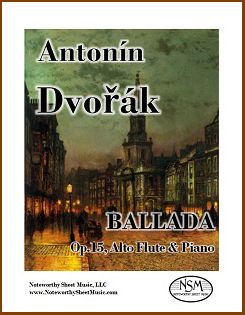 Ballada, Op. 15, by Antonín Dvořák
Ballada, Op. 15, by Antonín Dvořák
Transcribed for Alto Flute and Piano by C.A.Vater
Alto Flute Part and Piano Score, PDF $7.99
The Czech composer Antonín Leopold Dvořák (1841-1904) first visited England in 1884, at the invitation of the Philharmonic Society of London. He conducted several of his works there and and was commissioned to compose a new symphony for the Philharmonic Society, his Symphony No. 7 in D minor, Op.70, which he conducted in London on April 22, 1885. Dvořák, who was well-received in England for his longer works, including cantatas and oratorios, was asked by London publishers to write shorter compositions as well. The Ballada, composed by Dvořák in late 1884 shortly after he completed his Symphony No. 7, was written specifically for publication in the Christmas edition of the London Magazine of Music. It is a short work of approximately six minutes duration for violin and piano. Written in the key of D minor, the Ballad's outer sections are solemn and melancholy while the contrasting central Allegro agitato is fervid and intense. The piece works nicely on alto flute, and our transcription required few adaptations from the original violin part.
[Sources for Dvořák biographical information: Baker's Biographical Dictionary of Musicians (Eighth Edition, Revised by Nicolas Slonimsky) and the internet website http://www.antonin-dvorak.cz/en/ballad.]
Score, 8 pages; Alto Flute part, 3 pages; Total, 14 pages.
PreviewDvořák - Romance, Op. 11 - arr. for Flute Choir
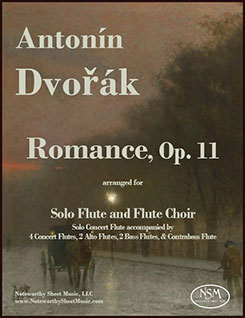 Romance, Op. 11 by Antonín Dvořák
Romance, Op. 11 by Antonín Dvořák
Arranged for Solo Flute and Flute Choir by C. A. Vater (originally for solo violin and orchestra)
Score and Parts for Solo Concert Flute, 4 Concert Flutes, 2 Alto Flutes, 2 Bass Flutes, and 1 Contrabass Flute, PDF $21.97
Czech composer Antonín Dvořák based his Romance, Opus 11 on the slow movement of his String Quartet in F minor, composed in 1873, re-working that Andante con moto quasi allegretto to create two versions of the Romance, one for solo violin and orchestra (B.39) and another for solo violin and piano (B.38). The Romance is one of Dvořák’s most magnificent melodic works, teaming with romance, lyricism, and emotional intensity. I created a solo flute version of this piece for my personal use, and I so enjoyed playing it that I shared it with a flutist friend / NSM editorial consultant, who suggested that the Romance might be nicely adaptable for flute choir. I took on that challenge and created this arrangement, scored for flute solo with the accompaniment of four concert flutes, two alto flutes, two bass flutes, and one contrabass flute. A few changes have been incorporated in the solo part, bringing the violin’s lowest notes into concert flute range and providing appropriate alternatives to the occasional double stops. Likewise, the various string and wind parts created by Dvořák for his orchestral arrangement (available on IMSLP.org) have been modified in places to suit members of the flute family. Of course, any work played by a flute choir will sound very different than when played by an orchestra, but in arranging this piece for flute choir, every effort has been made to maintain the spirit, character, balance, and flow of Dvořák’s exquisite Romance.
The parts in our edition have been formatted for convenient page turns when the complete PDF is printed 2-sided in its entirety. If a more compact version of the score is desired, however, please select a “2 pages per sheet” printer option for the score and print the score pages separately from the parts.
Score, 60 pages; Solo Flute part, 4 pages of music; Flutes 1-4 parts, each 3 pages of music; Alto Flute 1 part, 4 pages of music; Alto Flute 2 part, 3 pages of music; Contrabass Flute part, 3 pages of music; Total, 104 pages.
PreviewDvořák - Romantic Pieces - Alto Flute
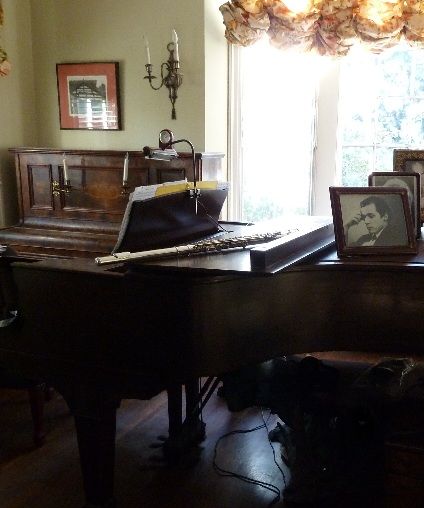 Romantische Stücke, Op.75, by Antonín Dvořák
Romantische Stücke, Op.75, by Antonín Dvořák
Transcribed for Alto Flute (and Piano) by J.W.Pratt and C.A.Vater
Alto Flute Part, PDF $6.99
Antonin Dvorak's Romantische Stücke (Romantic Pieces) was composed originally as a trio for two violins and viola but was later rearranged by the composer as a piece for violin and piano. We created a transcription of the violin part for alto flute; the piano part is readily available in the public domain as a free pdf download of the score for violin and piano. Here is a link to one such source: Piano Score.
Alto Flute part, 7 pages; Total, 10 pages.
PreviewDvořák - Sonatina - Alto Flute
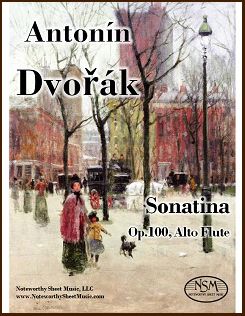 Sonatina, Op.100, by Antonín Dvořák
Sonatina, Op.100, by Antonín Dvořák
Transcribed for Alto Flute (and Piano) by J.W.Pratt and C.A.Vater
Alto Flute Part, PDF $11.99
Czech composer Antonin Dvorak wrote his charming Sonatina in G major for violin and piano in 1893, during his stay in the United States. Intended for Dvorak's own children but no less delightful for 21st century players of all ages, the piece is comprised of four short movements. We provide here a transcription of the violin part for alto flute, which suits the "New World" feeling especially well. We provide the alto flute part; the piano part is readily available in the public domain as a free pdf download of the score for violin and piano. Here is a link to one such source: Piano Score
Alto Flute part, 13 pages; Total 16 pages.
PreviewElgar - Chanson de Matin - AFl & Pf
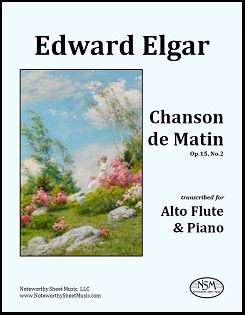 Chanson de Matin, Op.15, No.2, by Edward Elgar
Chanson de Matin, Op.15, No.2, by Edward Elgar
Transcribed for Alto flute and Piano by C.A.Vater
Alto Flute Part and Piano Score, PDF $6.99
Edward Elgar composed his Chanson de Matin for violin and piano c.1889-1890. The two companion pieces, Chanson de Matin (No. 2) and Chanson de Nuit (No. 1), together constitute his Op.15, and both pieces were later arranged for small orchestra by the composer. Chanson de Matin was received with great enthusiasm, and its initial and lasting popularity can be attributed largely to its strong melodic appeal. Enduring public affection for the piece has spawned the creation of numerous arrangements and transcriptions, including renditions for cello and piano, viola and piano, flute and guitar, piano solo, organ solo, and string quartet. Noteworthy Sheet Music offers two of our own transcriptions of the lovely Chanson de Matin, one for alto flute and piano and one for C-flute and piano.
Alto Flute part, 2 pages; Piano Score, 4 pages; Total, 12 pages.
PreviewElgar – Mot d’Amour – Alto Flute & Piano
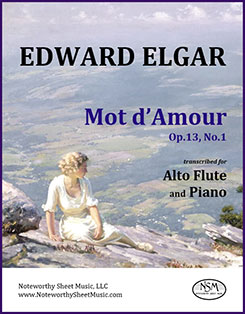 Mot d’Amour, Op.13, No.1, by Edward Elgar
Mot d’Amour, Op.13, No.1, by Edward Elgar
Transcribed for Alto Flute and Piano by C. A. Vater
Piano Score and Part for Alto Flute, PDF $5.49
In 1888, Elgar composed Salut d’Amour, now one of his most-recognized pieces, as an engagement gift for his beloved fiancée. Later he wrote Mot d'Amour (Love's Word) for violin and piano as a companion piece to Salut d’Amour. Mot d'Amour, which was initially given the German title Liebesahnung, was published in 1889 by Osborn & Tuckwood in the edition 2 Pieces for Violin & Piano that included this piece and a second one, less well-suited to alto flute, called Bizarrerie. Mot d’Amour is similar to Salut d’Amour in being light, charming, and highly romantic. Although Mot d’Amour never attained the level of popularity achieved by the earlier work, it is considered by some to be the finer composition (https://www.elgar.org/3salut.htm). Both Salut d’Amour and Mot d'Amour sound especially rich and mellow when performed on alto flute, and both pieces are now available from Noteworthy Sheet Music as transcriptions for alto flute and piano, adapted from the composer’s violin and piano editions now in the public domain and available on imslp.org.
Score, 4 pages; Alto Flute part, 1 page; Total, 8 pages.
Elgar – Salut d’Amour – Alto Flute & Piano
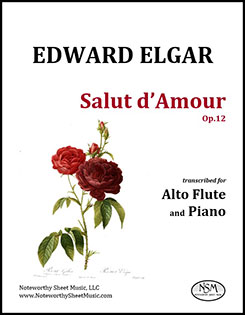 Salut d’Amour, Op. 12, by Edward Elgar
Salut d’Amour, Op. 12, by Edward Elgar
Transcribed for Alto Flute and Piano by C. A. Vater
Piano Score and Part for Alto Flute, PDF $6.99
The English composer Edward Elgar held many positions throughout his career, including those of organist at St. George’s Roman Catholic Church in Worcester, conductor of the Worcester Philharmonic, Professor of Music at the University of Birmingham, and conductor of the London Symphony Orchestra. He achieved considerable prominence as a result of his many successful orchestral, vocal, and chamber music compositions. Elgar composed this piece in 1888, as an engagement gift to his beloved future wife. Though first written for piano solo, arrangements were created shortly thereafter by the composer himself for violin and piano, and for orchestra. Originally titled “Liebesgruss” (Love’s Greeting), but later changed to Salut d’Amour, the piece is now one of Elgar’s most widely recognized works, and its immense popularity has led to arrangements for a wide variety of other instruments. We provide here a transcription of Salut d’Amour for alto flute and piano, which has been adapted from the editions published by Schott for violin and piano, oboe and piano, or orchestra and which are now in the public domain.
Score, 4 pages; Alto Flute part, 2 pages; Total, 10 pages.
PreviewFalla - Siete Canciones populares Españolas - Alto Flute (& piano)
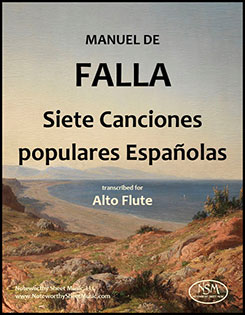 Seven Spanish Folksongs, by Manuel de Falla
Seven Spanish Folksongs, by Manuel de Falla
Transcribed for Alto Flute (and piano) by C. A. Vater
Alto Flute part, PDF $8.99
The seven songs included in the original voice and piano publication, as well as in our alto flute part edition, are El Paño Moruno (“The Moorish Cloth”), Seguidilla murciana (an old dance form, omitted in the Kochánski violin and piano version), Asturiana (a lament from the northern part of Spain), Jota (a familiar dance form from the north east of Spain), Nana (an Andalusian lullaby), Canción (“Song”), and Polo (reminiscent of the zapateado, a Spanish dance rich in flamenco rhythms). This information and an in-depth analysis of the Siete canciones populares españolas, including historical and regional background, music analysis, and an English translation of the lyrics, can be found in the excellent article by composer and conductor Gianmaria Griglio, co-founder and Artistic Director of ARTax Music.
Alto Flute part, 8 pages; Total,10 pages. (pdf of piano accompaniment is freely available at imslp.org)
PreviewFauré - Berceuse - Alto Flute & Piano
Berceuse, Op.16, by Gabriel Fauré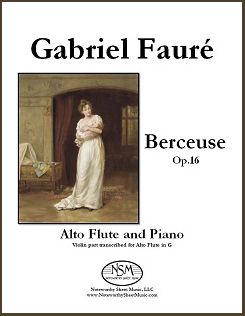
Transcribed for Alto Flute and Piano by C.A.Vater
Piano Score and Alto Flute Part, PDF $6.99
Gabriel Fauré composed his Berceuse (Op. 16) for violin (or cello) and piano in 1878-1879, and it was first published by J. Hamelle, Paris. To this day, the Berceuse remains one of Fauré's most beloved and popular works. The piece is simple but beautiful, short, with a quiet sweet melody that appeals to both performers and audiences alike. It is no wonder that over the years the Berceuse has been transcribed for many other instruments; arrangements have been created for solo piano, viola, flute, alto saxophone, flute and harp, and string quartet, in addition to the composer's own arrangement for violin and orchestra.
Now, in response to an excellent suggestion we received from one of our customers, we add our own version of the Fauré Berceuse, a transcription for alto flute and piano. Perhaps we are biased, but we think the alto flute is a wonderful instrument choice for this lullaby. The piece is suitable for players of all levels.
Alto Flute part, 2 pages; Piano Score, 5 pages; Total, 12 pages.
PreviewFauré - Pièce - Alto Flute & Piano
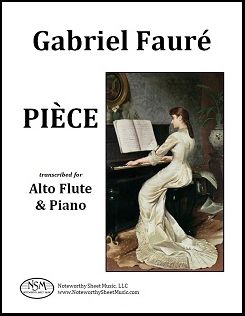 Pièce (Vocalise-Étude), by Gabriel Fauré
Pièce (Vocalise-Étude), by Gabriel Fauré
Transcribed for Alto Flute and Piano by C.A.Vater
Alto Flute Part and Piano Score, PDF $4.99
Vocalises are songs without words written to provide technical challenges for singers; they are designed to develop flexibility and control, and thus often serve as vocal warm-up exercises. Gabriel Fauré composed his Vocalise-Étude in 1906, and it was published by Leduc the following year. The original piece, in the key of E minor and marked Adagio molto tranquillo, includes a piano accompaniment and incorporates various difficulties for the vocal soloist, including wide intervals, unexpected harmonies, and demanding rhythms.
Fauré's Vocalise-Étude has long been recognized as a particularly lovely and poignant piece of music, not merely a vocal exercise but a musical work of intrinsic beauty. Under its alternative name Pièce, the Vocalise-Étude has been transcribed for various orchestral instruments, including bassoon and piano, flute and piano, and oboe and harp. We at Noteworthy Sheet Music think the alto flute, with its rich, mellow tone, is the perfect instrument for this moving and somewhat melancholy Fauré melody. Our transcription for alto flute and piano is based on the version of the Vocalise-Étude for medium voice, in the key of D minor, published by Alphonse Leduc in 1907 and now in the public domain.
Alto Flute part, 1 page; Piano Score, 3 pages; Total, 8 pages.
Preview